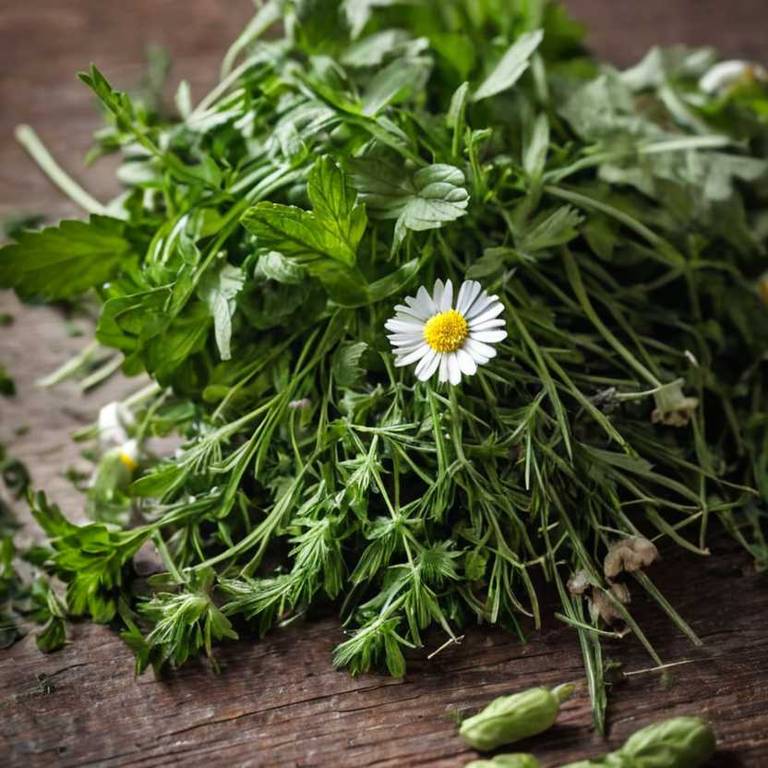By Leen Randell
Updated: Jul 20, 2024
10 Medicinal Constituents Of Bellis Perennis (Daisy)

Bellis perennis has active constituents such as triterpene saponins, flavonoids, and phenolic acids.
These constituents possess anti-inflammatory, antimicrobial, and antioxidant properties, which can alleviate symptoms of arthritis, improve wound healing, and protect against cell damage.
For example, the anti-inflammatory properties of daisy can help reduce joint pain and swelling, while its antimicrobial properties can aid in the treatment of skin infections.
This article explains in details the 10 best active constituents of Bellis perennis.
1. Flavonoids
Bellis perennis flavonoids is a group of bioactive compounds that have been isolated from its flowers.
These flavonoids have been reported to possess numerous biological activities, including antioxidant, anti-inflammatory, and antimicrobial properties.
The main flavonoids present in Bellis perennis are apigenin, luteolin, and kaempferol, which may contribute to the plant's traditional uses for treating various diseases such as fever, inflammation, and skin conditions.
2. Saponins
Bellis perennis saponins is a type of natural compound found in the flowers and leaves of this plant.
Saponins are a class of glycosides that can exhibit surface-active properties, resulting in foaming and emulsification when mixed with water.
Bellis perennis saponins have been shown to possess various biological activities, including antioxidant, anti-inflammatory, and antimicrobial properties, making them a promising area of research for potential therapeutic applications.
3. Phenolic acids
Bellis perennis phenolic acids is a type of secondary metabolite found in its flowers and leaves.
These compounds are responsible for the plant's antimicrobial and antioxidant properties, which play a crucial role in protecting it from pathogens and environmental stressors.
Phenolic acids in Bellis perennis have been shown to exhibit significant biological activities, including anti-inflammatory and anticancer effects, making them of great interest for potential applications in pharmaceuticals and medicine.
4. Triterpenes
Bellis perennis triterpenes is a type of compound found in its flowers and leaves.
Triterpenes are a class of natural compounds that have been shown to possess anti-inflammatory and antioxidant properties.
They have been isolated from Bellis perennis and studied for their potential therapeutic applications, including the treatment of inflammatory diseases such as arthritis and skin conditions.
5. Luteolin
Bellis perennis luteolin is a flavonoid compound that plays a crucial role in its medicinal properties.
It has been shown to possess anti-inflammatory, antibacterial, and antiviral activities, making it effective against various infections and diseases. Luteolin has also been found to have antioxidant properties, which can help protect the body from oxidative stress and cell damage.
Its potential health benefits are numerous, including reducing inflammation, improving cognitive function, and boosting the immune system.
6. Kaempferol
Bellis perennis kaempferol is a flavonoid compound found in various parts of the plant.
It has been extensively studied for its potential health benefits, including anti-inflammatory and antioxidant properties. Kaempferol has been shown to exhibit cytotoxicity against certain cancer cell lines and may have protective effects on the cardiovascular system.
Additionally, it has been used in traditional medicine for centuries to treat a range of ailments, from skin conditions to respiratory issues.
7. Quercetin
Bellis perennis quercetin is a flavonoid compound found in its flowers and leaves.
This bioactive molecule has been extensively studied for its potential health benefits, including anti-inflammatory, antioxidant, and antimicrobial properties.
Quercetin has been shown to inhibit the production of pro-inflammatory chemicals, making it a promising natural remedy for conditions such as arthritis, asthma, and allergies.
8. Chlorogenic acid
Bellis perennis chlorogenic acid is a type of phenolic compound found in its flowers and leaves.
This natural antioxidant has been studied for its potential health benefits, including anti-inflammatory, antimicrobial, and antiviral properties. Chlorogenic acid may help protect against oxidative stress, improve cardiovascular health, and even exhibit anticancer effects.
Further research is needed to fully understand its effects on human health.
9. Caffeoylquinic acids
Bellis perennis caffeoylquinic acids is a class of bioactive compounds found in the flowers and leaves of this plant.
These acids have been studied for their potential health benefits, including anti-inflammatory, antioxidant, and antimicrobial properties.
They have also been shown to exhibit antiviral activity against certain viruses, making them a promising area of research for developing new treatments for various diseases.
10. Furocoumarins
Bellis perennis furocoumarins is a type of plant compound found in its leaves and flowers.
These compounds have been shown to exhibit phototoxic properties, meaning they can cause skin reactions or burns when combined with sunlight exposure.
Furocoumarins are responsible for the allergic contact dermatitis caused by handling or touching the daisy plant, and are also known to interact with DNA, leading to increased risk of skin cancer and other health issues.